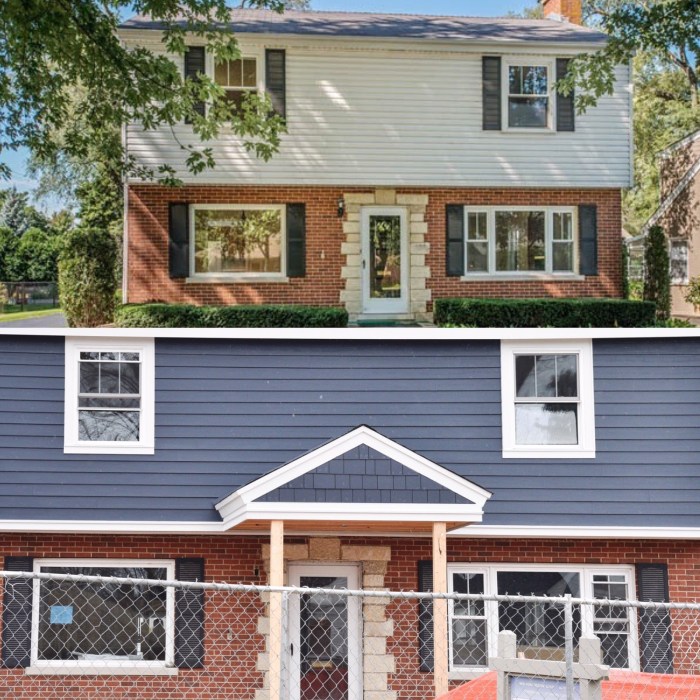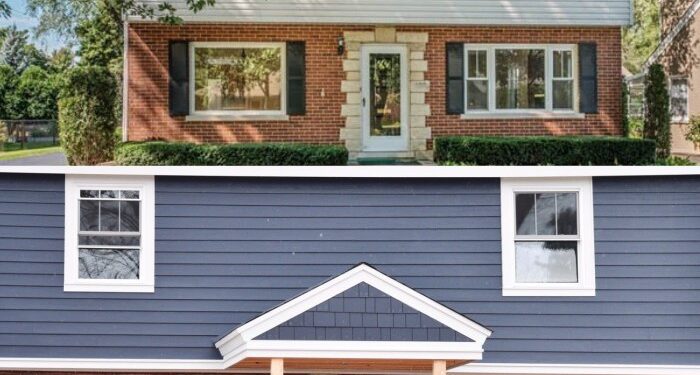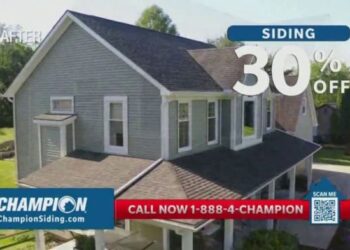Brick and siding exterior introduces a unique blend of materials that elevate the aesthetics of buildings and homes. This dynamic duo offers a versatile canvas for architectural creativity and design innovation, setting the stage for a captivating exploration of construction and style.
As we delve deeper into the realm of brick and siding exteriors, a world of possibilities unfolds, showcasing the harmonious marriage of tradition and modernity in the realm of construction.
Introduction to Brick and Siding Exterior
A brick and siding exterior refers to a building or house exterior that combines both brick and siding materials in its construction. This design choice offers a mix of durability, aesthetic appeal, and versatility.
Common characteristics of brick and siding exteriors include a blend of textures and colors, providing a unique and visually interesting look to the structure. The combination of brick and siding also offers a balance between traditional and modern architectural styles.
Examples of Buildings or Houses with Brick and Siding Exteriors
- The classic colonial-style houses in New England often feature brick and siding exteriors, showcasing a timeless appeal.
- Modern commercial buildings in urban areas frequently use brick and siding exteriors to create a sleek and contemporary look while maintaining durability.
- Suburban homes with a mix of brick and siding exteriors offer a cozy and welcoming atmosphere, blending in seamlessly with the surrounding neighborhood.
Benefits of Using Brick and Siding Exteriors
Brick and siding exteriors offer a range of benefits that make them popular choices for construction and design projects. Let's explore the advantages of using brick for exterior construction and the benefits of incorporating siding into your exterior design. We will also compare the durability of brick versus siding exteriors.
Advantages of Using Brick for Exterior Construction
Brick exteriors are known for their durability and longevity, with some brick buildings lasting for centuries. They require minimal maintenance and are resistant to fire, pests, and harsh weather conditions. Additionally, bricks provide excellent insulation, helping to regulate indoor temperatures and reduce energy costs.
The timeless aesthetic appeal of brick adds a touch of elegance and sophistication to any property.
Benefits of Using Siding for Exterior Design
Siding offers a versatile and cost-effective solution for enhancing the visual appeal of your property. Available in a variety of colors, textures, and styles, siding allows for endless design possibilities. It is easy to install and requires minimal upkeep, making it a popular choice for homeowners looking to improve their home's exterior without breaking the bank.
Siding also helps to protect the underlying structure from moisture and impact damage.
Comparison of Durability: Brick vs. Siding Exteriors
When it comes to durability, brick is often considered the superior choice. Brick exteriors can withstand extreme weather conditions, resist fading and discoloration, and are less prone to damage from impacts. Siding, while durable in its own right, may require more frequent maintenance and replacement over time.
However, advancements in siding materials have improved their longevity and durability, making them a viable option for those looking for a balance between aesthetics and practicality.
Design Options for Brick and Siding Exteriors
Brick and siding exteriors offer a wide range of design options to enhance the overall look of your home. By combining these two materials creatively, you can achieve a unique and visually appealing exterior that reflects your personal style.
Design Styles Achievable with Brick Exteriors
Brick exteriors are versatile and can be used to create various design styles, including:
- Traditional: Classic red brick with a timeless appeal, perfect for a traditional look.
- Modern: Sleek and minimalist designs using white or grey bricks for a contemporary feel.
- Rustic: Exposed brick walls with a weathered finish for a warm and inviting look.
- Cottage: Soft-colored bricks with a textured surface for a cozy cottage aesthetic.
Siding Options for Exterior Aesthetics
When it comes to siding options for your home exterior, you have a multitude of choices, such as:
- Vinyl: Affordable and low-maintenance, available in a wide range of colors and textures.
- Fiber Cement: Durable and versatile, mimicking the look of wood, stucco, or stone.
- Wood: Natural and timeless, offering a warm and inviting feel to your home.
- Brick Veneer: Thin slices of real brick for a traditional look without the weight and cost.
Tips for Combining Brick and Siding
To create a cohesive and visually appealing exterior using both brick and siding, consider the following tips:
- Balance: Use a combination of brick and siding in a balanced way to create visual interest.
- Color Coordination: Choose colors that complement each other to achieve a harmonious look.
- Texture Mix: Experiment with different textures to add depth and dimension to your exterior.
- Accent Features: Use siding as an accent to highlight architectural details or create focal points.
Maintenance and Care for Brick and Siding Exteriors

Brick and siding exteriors require regular maintenance to ensure they remain in good condition and preserve the overall appearance of your home. Proper care routines can also extend the lifespan of these materials, saving you money in the long run.
Maintenance Requirements for Brick Exteriors
- Inspect the mortar regularly for any cracks or deterioration and repair as needed to prevent water infiltration.
- Clean the brick surface with a gentle detergent and water to remove dirt, mold, or mildew buildup.
- Seal the brick every few years to protect it from moisture and harsh weather conditions.
Care Routines for Different Types of Siding Materials
Proper care routines for siding materials vary depending on the type of material used. Here are some general guidelines:
- Vinyl Siding:Clean with a mixture of water and mild soap, rinse with water, and inspect for any damage or loose panels regularly.
- Wood Siding:Apply a fresh coat of paint or stain every few years to protect the wood from rot and moisture damage. Inspect for any signs of insect infestation or water damage.
- Fiber Cement Siding:Clean with a mixture of water and mild detergent, inspect for any cracks or chips, and repaint if necessary to maintain its protective layer.
Weather Conditions and Maintenance of Brick and Siding Exteriors
Weather conditions can have a significant impact on the maintenance of brick and siding exteriors. Here are some factors to consider:
- Harsh sunlight can cause fading and deterioration of siding materials over time, requiring more frequent maintenance and repainting.
- Heavy rain and moisture can lead to mold or mildew growth on brick surfaces, necessitating regular cleaning and sealing to prevent damage.
- Cold temperatures and freezing conditions can cause expansion and contraction of materials, potentially leading to cracks or gaps that need to be addressed promptly.
Cost Considerations for Brick and Siding Exteriors
When it comes to choosing between brick and siding exteriors, cost plays a significant role in the decision-making process. Let's dive into the key cost considerations for both options.
Cost Factors for Installing a Brick Exterior
Installing a brick exterior can be a substantial investment due to the materials and labor involved. The cost of bricks can vary depending on the type, quality, and style chosen. Additionally, the installation process for brick exteriors is labor-intensive, which can further add to the overall cost.
It's essential to consider these factors when budgeting for a brick exterior.
Expenses Involved in Choosing Siding for an Exterior
Siding exteriors offer a more cost-effective alternative to brick. The materials used for siding, such as vinyl, fiber cement, or wood, are generally less expensive than bricks. The installation process for siding is also quicker and requires less labor, which can help reduce overall costs.
However, it's crucial to factor in the long-term maintenance and potential replacement costs when choosing siding for an exterior.
Long-Term Costs of Maintaining Brick versus Siding Exteriors
While the initial cost of installing a brick exterior may be higher, bricks are known for their durability and low maintenance requirements. This can result in lower long-term maintenance costs compared to siding exteriors, which may require more frequent painting, repairs, or replacement over time.
When weighing the long-term costs of maintaining brick versus siding exteriors, it's essential to consider the lifespan and maintenance needs of each option to make an informed decision based on your budget and preferences.
Last Point
In conclusion, the fusion of brick and siding exteriors embodies a timeless elegance and practical functionality that stand the test of time. From design versatility to durability, this combination continues to captivate admirers and inspire architectural visions for the future.
FAQs
What are the key characteristics of brick and siding exteriors?
Brick exteriors offer durability and a classic look, while siding provides versatility and easy maintenance. Together, they create a harmonious blend of aesthetics and functionality.
How do weather conditions impact maintenance for brick and siding exteriors?
Extreme weather can affect the lifespan of both brick and siding exteriors, requiring regular inspections and maintenance to ensure longevity.
What are some popular design styles achievable with brick exteriors?
Common design styles include traditional red brick facades, modern exposed brick walls, and rustic brick accents for a timeless appeal.














